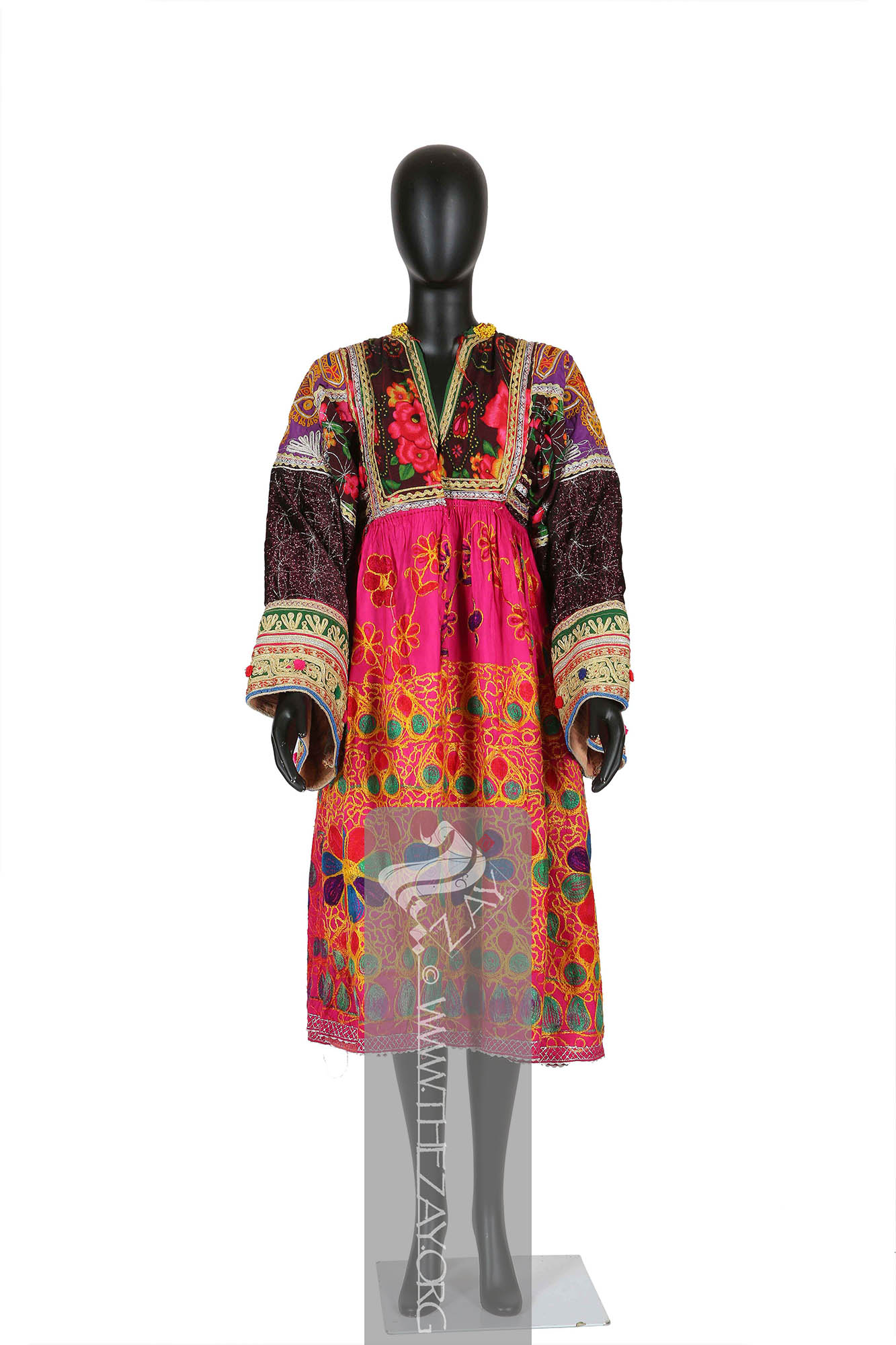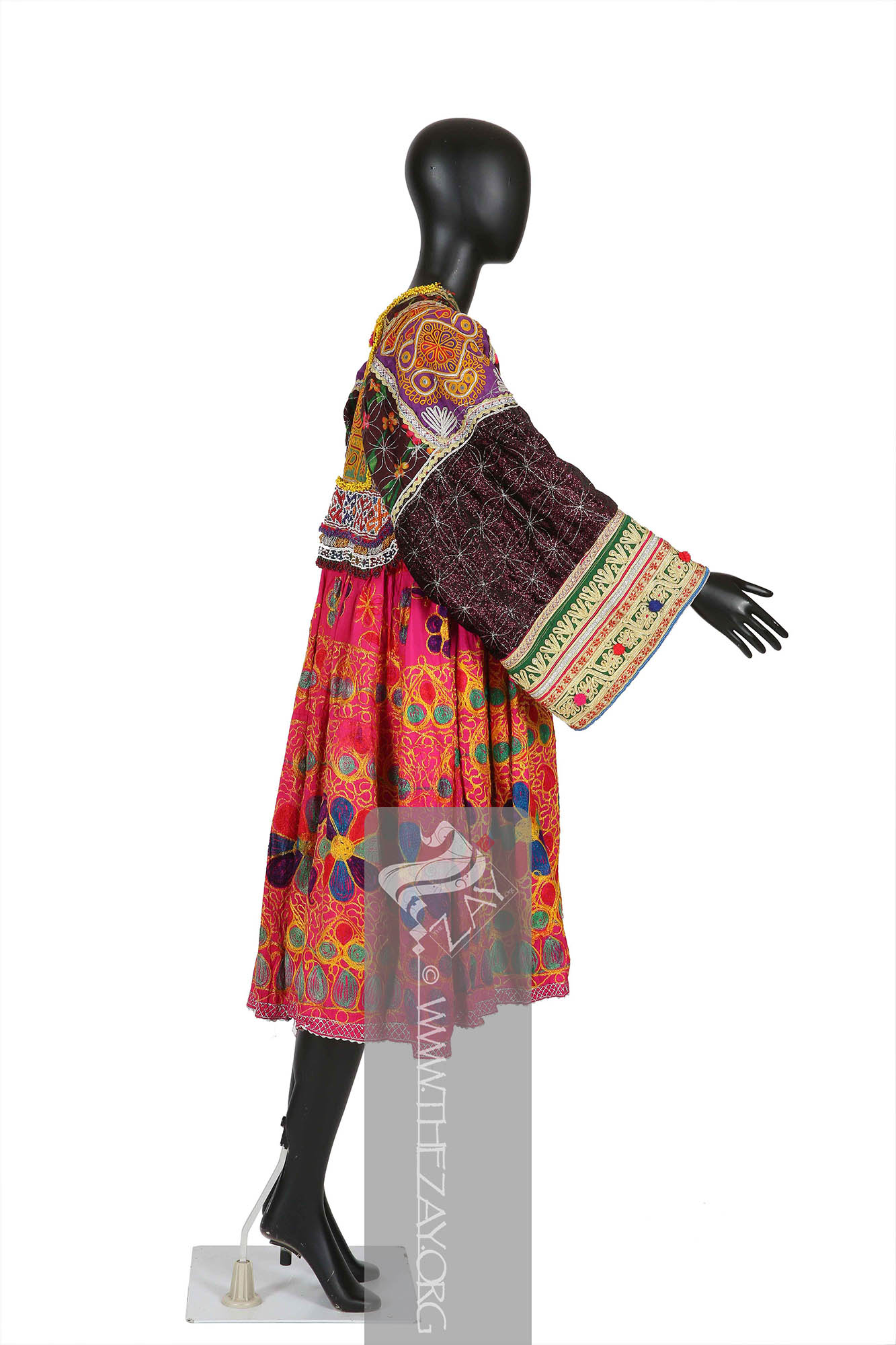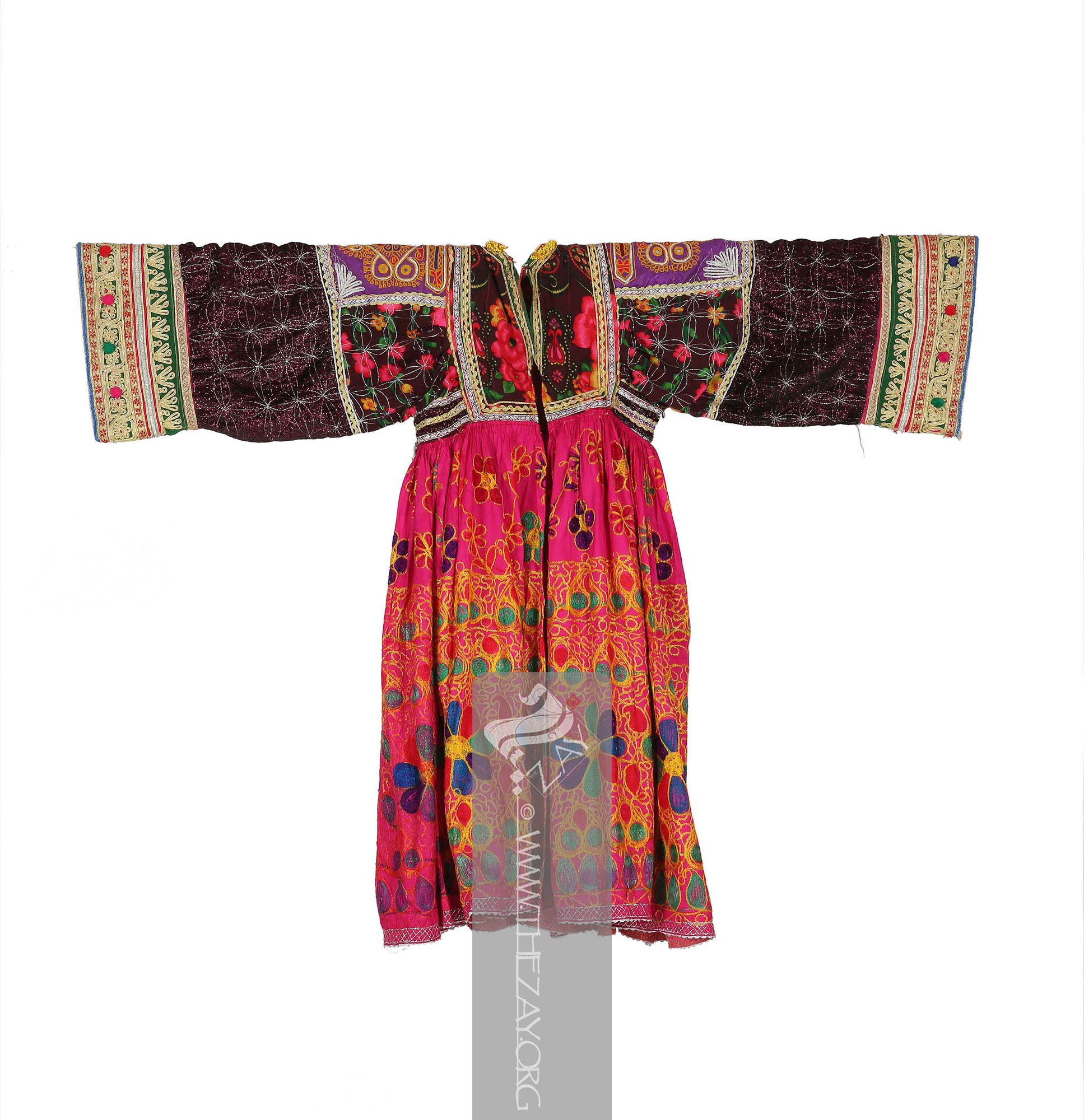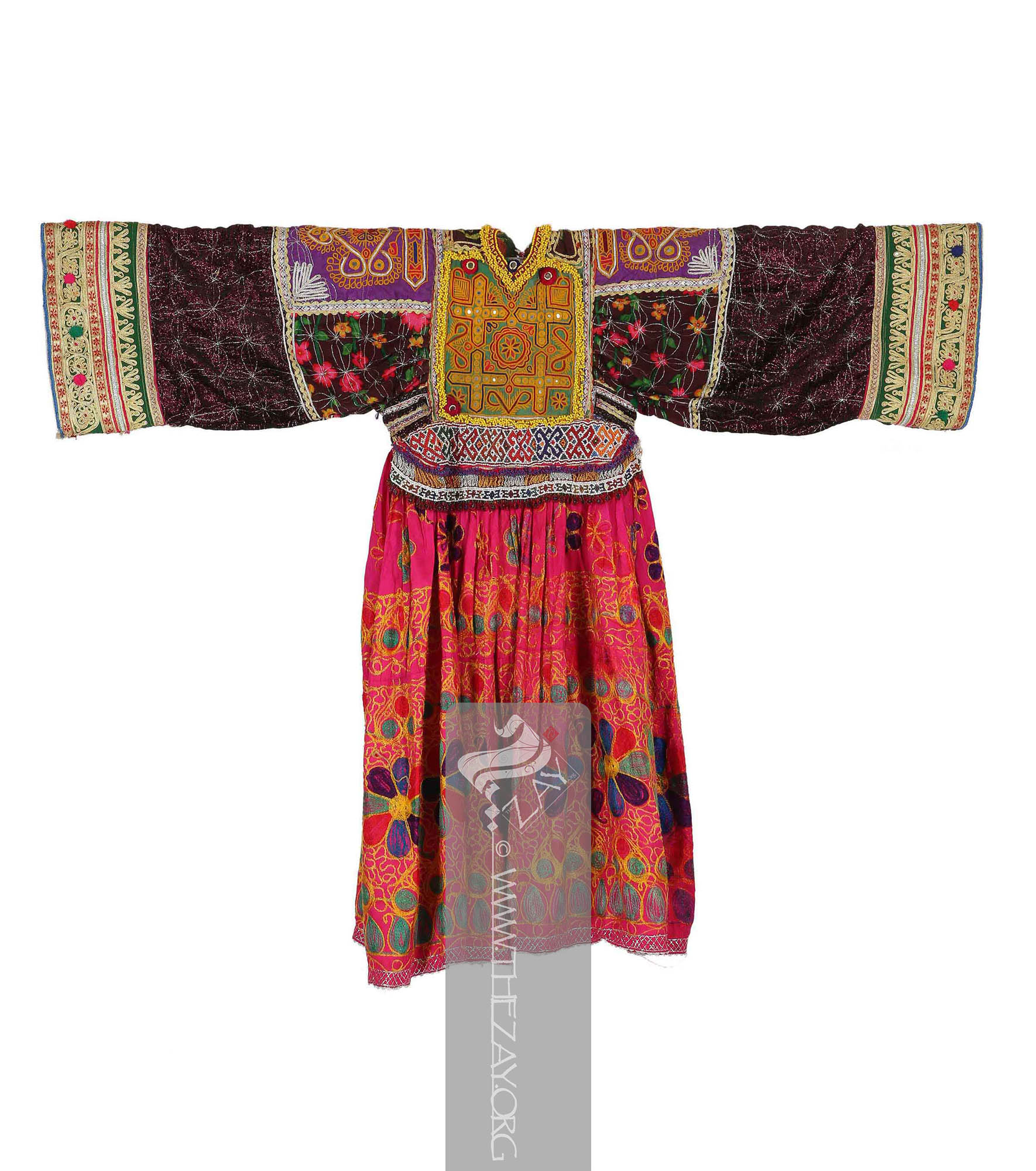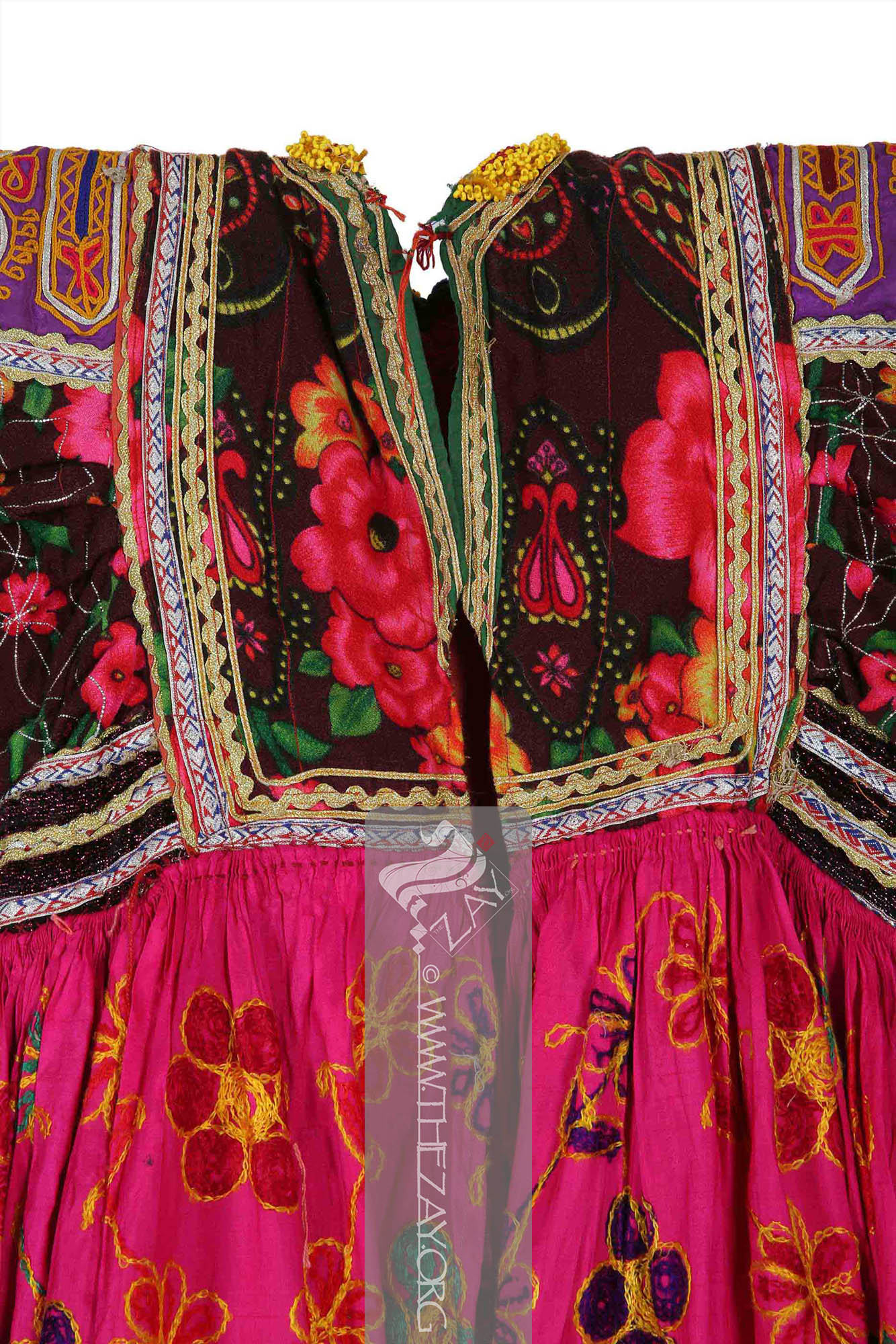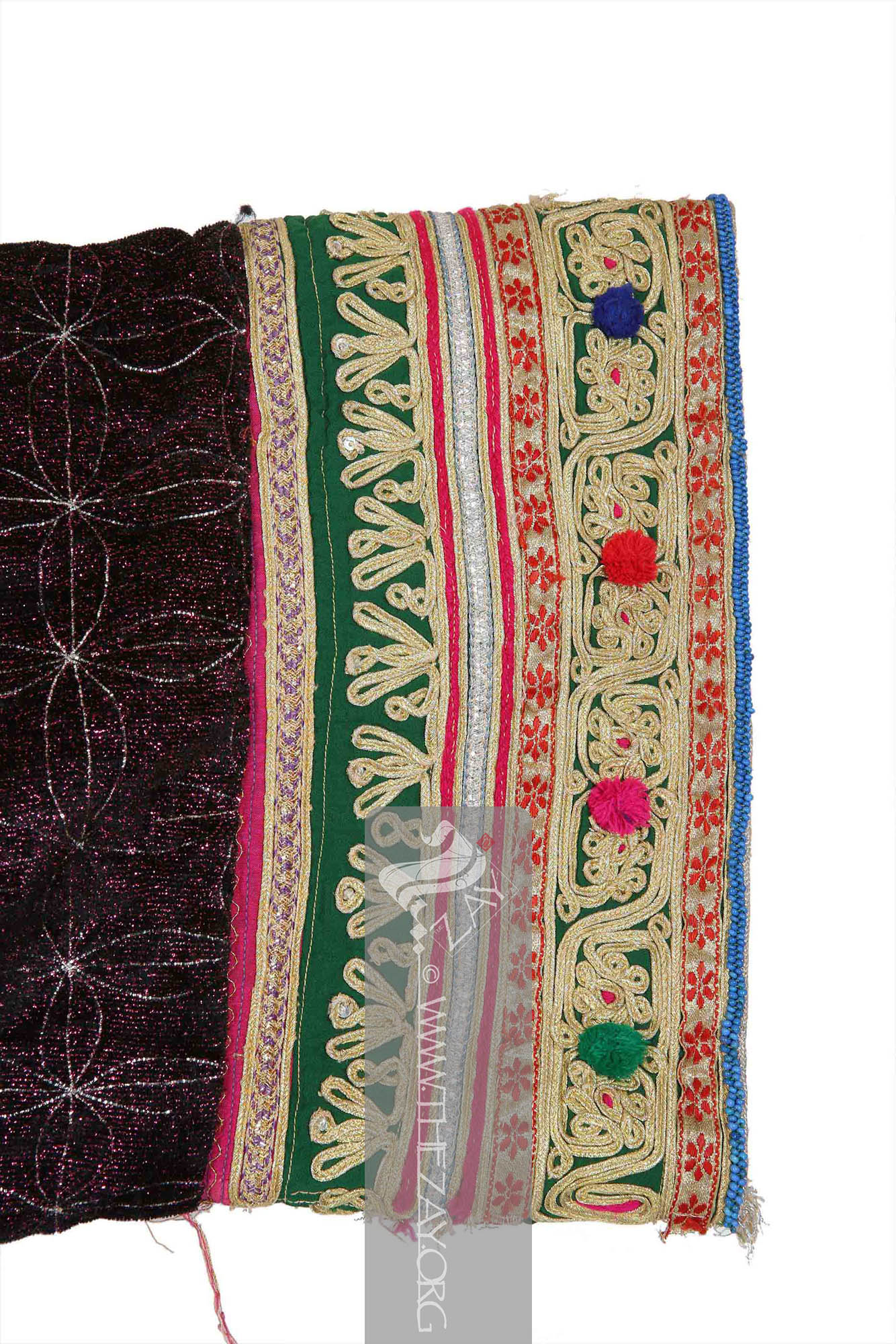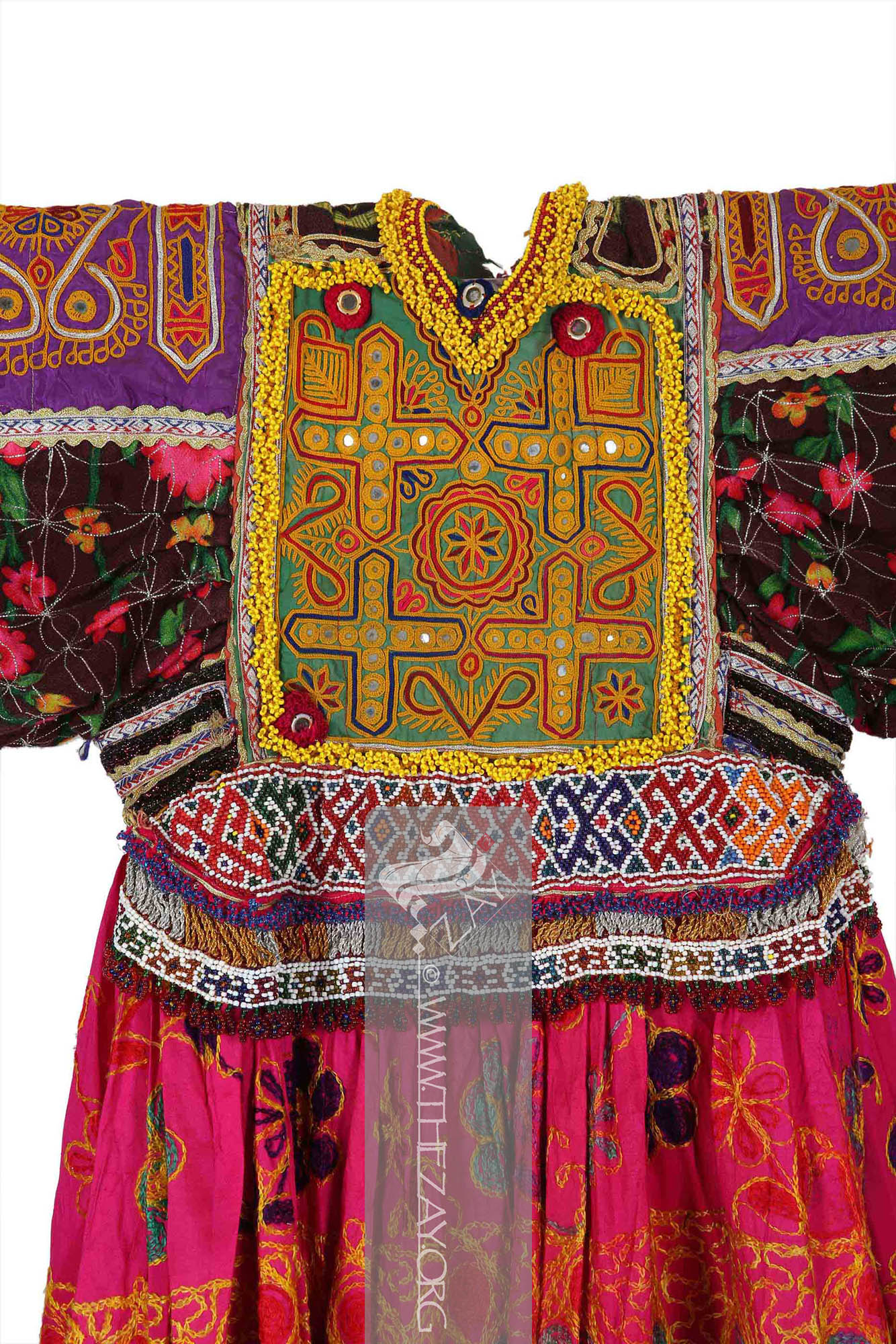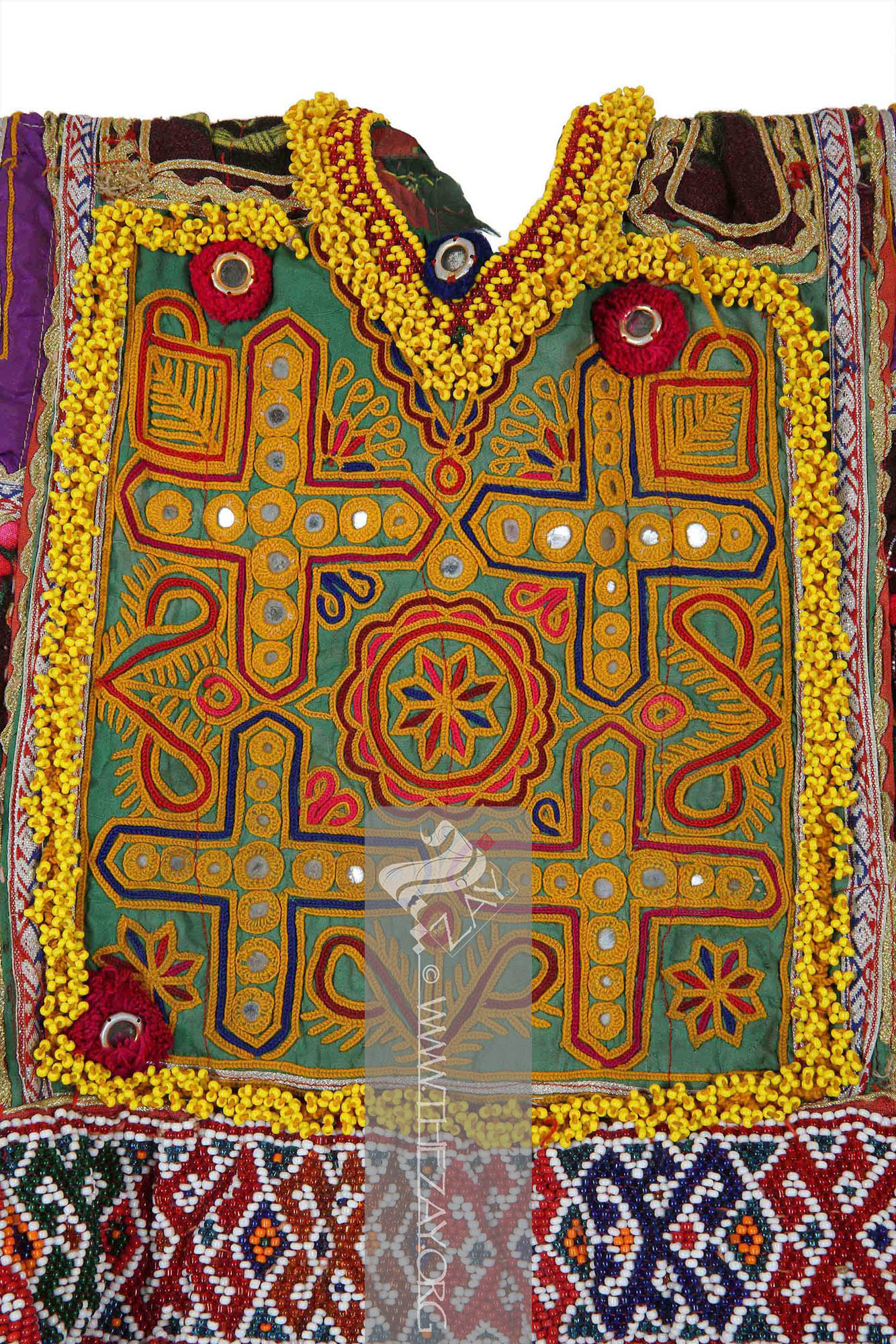Object HistoryThis colourful woman’s tunic belonging to the Kochi tribes native to Afghanistan and Baluchistan province in Pakistan was purchased at the Sharjah Islamic Market (suq), recently named The Blue Souk, in the UAE by
Dr. Reem Tariq
Ṭariq: (Arabic; Synonym: tulle_bi_talli
Tūlle_bi_tallī: (French: Tulle – a city in France where fine material for veil was first made; Turkish: tel – wire; Synonym: tariq; talli; badla; khus_dozi ), series of small metal knots made on a woven net ground as embellishment. The term is commonly used in the North African Arab region specifically in Egypt.
; talli; badla; khus_dozi ), series of small metal knots made on a woven net ground as embellishment. The term is commonly used in the Levant Arab region specifically in Lebanon.
El Mutwalli
Dr. Reem Tariq
Ṭariq: (Arabic; Synonym: tulle_bi_talli
Tūlle_bi_tallī: (French: Tulle – a city in France where fine material for veil was first made; Turkish: tel – wire; Synonym: tariq; talli; badla; khus_dozi ), series of small metal knots made on a woven net ground as embellishment. The term is commonly used in the North African Arab region specifically in Egypt.
; talli; badla; khus_dozi ), series of small metal knots made on a woven net ground as embellishment. The term is commonly used in the Levant Arab region specifically in Lebanon.
el Mutwallī: Founder (CEO) of the Zay
Zay: (Arabic: costume, Pl. azyaā’), a set of clothes in a style typical of a particular country or historical period. Initiative, a public figure, speaker and author. An expert curator and consultant in Islamic art and architecture, interior design, historic costume, and UAE heritage. in 1999. It was eventually added to The
Zay
Zay: (Arabic: costume, Pl. azyaā’), a set of clothes in a style typical of a particular country or historical period. Initiative.
Object Features This is a Kochi tribal women’s tunic dress with a fuchsia pink silk skirt, a brown printed woollen (
bodice_yoke
Bodice_Yoke: (Synonym: Yoke
Yoke: (Synonym: Bodice_Yoke), a structured pattern fitted at the shoulders defining the structure of women’s garments. Introduced in c. 1880s it defines the transition between the upper and lower parts of the garments and can now be found stitched-in where the blouse is separated from the skirt by a horizontal seam. ), a structured pattern fitted at the shoulders defining the structure of women’s garments. Introduced in c. 1880s it defines the transition between the upper and lower parts of the garments and can now be found stitched-in where the blouse is separated from the skirt by a horizontal seam. )/(
yoke
Yoke: (Synonym: Bodice_Yoke), a structured pattern fitted at the shoulders defining the structure of women’s garments. Introduced in c. 1880s it defines the transition between the upper and lower parts of the garments and can now be found stitched-in where the blouse is separated from the skirt by a horizontal seam. ) and velvet sleeves. The dress was perhaps repurposed.
A full skirt with pleats it is embellished with (
suzani
Suzani: (Farsi: suzandozi : needlework, from Farsi: suzan: needle, dozi: embellishment), type of embroidered and decorative Central Asian tribal textile art usually on a cotton fabric, embroidered in both silk or cotton thread with primarily chain, satin, and buttonhole stitches as well as couching technique. ) style embroidery primarily in (
chain_stitch
Chain_stitch: An embroidery technique where a looped stitch is made in a continuous chain-like pattern. Each stitch is formed by looping the thread through the previous stitch, creating a linked chain. ) technique with yellow, blue and green silk
floss
Floss: (Old French: flosche – nap of velvet), is a type of silk fibre obtained from the cocoons of wild silkworms. It is characterized by its long, fluffy fibers that are not tightly woven, making it ideal for use in various textile applications such as embroidery, lace-making, and sewing. threads. The hem of the fall has a border in plastic silver foil sewn to the piece in (
couching
Couching: (Latin: collocare – Place together), in needlework and embroidery couching is a technique in which yarn or other materials are laid across the surface of the ground fabric and fastened in place with small stitches of the same or a different yarn
) style with scalloped edging in metal corded threads.
The middle of the skirt is folded inside and stitched possibly to shorten its length for a later wearer. The dress had been repurposed further by parting the front completely to be used as a cape or jacket. Before cutting it, the front
yoke
Yoke: (Synonym: Bodice_Yoke), a structured pattern fitted at the shoulders defining the structure of women’s garments. Introduced in c. 1880s it defines the transition between the upper and lower parts of the garments and can now be found stitched-in where the blouse is separated from the skirt by a horizontal seam. was constructed of a vibrantly printed woollen fabric with floral motifs with metallic edging ribbons as borders in golden and silver colours.
The shoulders are constructed of lavender silk patches with
suzani
Suzani: (Farsi: suzandozi : needlework, from Farsi: suzan: needle, dozi: embellishment), type of embroidered and decorative Central Asian tribal textile art usually on a cotton fabric, embroidered in both silk or cotton thread with primarily chain, satin, and buttonhole stitches as well as couching technique. style embroidery in yellow, pink, blue and
crimson
Crimson: (Persian/Arabic and Turkish: qirmiz or kirmiz – red), is a vivid red color originally made from the dried bodies of a scale insect of the Kermes genus native to the Mediterranean region and was used as a dye for clothing and textiles. with mirror inlay. The back of the
yoke
Yoke: (Synonym: Bodice_Yoke), a structured pattern fitted at the shoulders defining the structure of women’s garments. Introduced in c. 1880s it defines the transition between the upper and lower parts of the garments and can now be found stitched-in where the blouse is separated from the skirt by a horizontal seam. has a green silk bed upon which is also embellished with
suzani
Suzani: (Farsi: suzandozi : needlework, from Farsi: suzan: needle, dozi: embellishment), type of embroidered and decorative Central Asian tribal textile art usually on a cotton fabric, embroidered in both silk or cotton thread with primarily chain, satin, and buttonhole stitches as well as couching technique. style embroidery with yellow, blue, pink and shades of red threads and mirror inlay depicting floral and geometric motifs.
Often such patches would turn out to be parts of (
shawl
Shawl: (Persian: shāl from Hindi: duśālā – Shoulder Mantle), a shawl is a South Asian version of a scarf worn or wrapped loosely over the shoulders and is usually made of wool. ) that was later repurposed as part of a dress. The green silk base also features four pompoms in woollen threads and embedded mirrors on all four corners out of which one is missing perhaps damaged. This green base fabric is bordered with a thick trimming of yellow plastic beads (
gul_i_peron
Gul_i_peron: (Farsi and Urdu: Gul – Flower; or Turkish: Rose; Farsi and Urdu: Pairahan – Garment or Shirt), a fabric embellishment craft of ancient Persian origin involving heavy beadwork often featuring floral motifs and a mirror centrepiece to deflect evil eye from the wearer. It is still famous in South and Central Asia. ) that also run around the v-shaped neck and is accompanied by red beading.
The sleeves are made of glittery velvet with plastic silver foil sewn to form repeats of large four-petalled floral motifs in a geometric style. The cuffs are made of rather broad patches of cotton fabric embroidered with a ribbon or trimming of golden metallic thread wrapped around a thick cotton strip in multiple tiers alternated with a thin
brocade
Brocade: (Italian: brocco – twisted thread), is a richly decorative fabric woven with an intricate raised pattern. Its origins can be traced back to ancient China, where it was made for the imperial court. It later spread to Europe during the Renaissance and became popular in couture and decorative arts. panel and a silver plastic foil trimming. An additional layer of embellishment is rendered to the dress with the colourful woollen pompoms sewn over the metal trimmings. The sleeves are finished with a blue plastic beaded edging.
The back of the skirt around the waist has an extra flap of fabric densely embroidered with plastic beads in
gul_i_peron
Gul_i_peron: (Farsi and Urdu: Gul – Flower; or Turkish: Rose; Farsi and Urdu: Pairahan – Garment or Shirt), a fabric embellishment craft of ancient Persian origin involving heavy beadwork often featuring floral motifs and a mirror centrepiece to deflect evil eye from the wearer. It is still famous in South and Central Asia. style and metallic threads in a variety of colours mostly depicting geometric patterns. This flap was separately constructed on a thick transparent plastic base and was sewn to the dress.
The piece is lined with patches of plain cotton fabric on its
yoke
Yoke: (Synonym: Bodice_Yoke), a structured pattern fitted at the shoulders defining the structure of women’s garments. Introduced in c. 1880s it defines the transition between the upper and lower parts of the garments and can now be found stitched-in where the blouse is separated from the skirt by a horizontal seam. and sleeves.
Interestingly, most of these dresses that are found in the West today are samples from c. 1970s Afghanistan.
Although traditional women’s dresses of nomadic pastoral tribes, the flamboyancy of these dresses became synonymous with Afghanistan thus identifying the country to the West, especially during the hippie era.
Links
- Valérie Bérinstain, Mary Hunt Kahlenberg, Zaira Mis, Marcel Mis. Asian Costumes and Textiles from the Bosphorus to Fujiyama: The Zaira and Marcel Mis Collection. California: Skira, 2001.
- Suleman, Fahmida. Textiles of the Middle East and Central Asia (British Museum) The Fabric of Life. London: Thames and Hudson, 2017.
- Embroidery from Afghanistan Fabric, folios. Sheila Paine. Washington: University of Washington Press, 2006.
- Sukhareva, Olʹga Aleksandrovna. Suzani
Suzani: (Farsi: suzandozi : needlework, from Farsi: suzan: needle, dozi: embellishment), type of embroidered and decorative Central Asian tribal textile art usually on a cotton fabric, embroidered in both silk or cotton thread with primarily chain, satin, and buttonhole stitches as well as couching technique. : Central Asian Decorative Embroidery. Samarkand: SMI Asia, 2013.
- https://referenceworks.brillonline.com/entries/encyclopaedia-iranica-online/clothing-COM_7759?lang=fr#COM-10186
- https://trcleiden.nl/trc-digital-exhibition/index.php/dressing-the-stans/item/109-decorative-needlework
- https://trc-leiden.nl/trc-digital-exhibition/index.php/afghan-dress/item/72-hamid-karzai-and-afghan-unification
- https://trc-leiden.nl/trc-digital-exhibition/index.php/afghan-dress/item/74-baluchi-dress
- https://www.wearableheritage.com/gul-i-peron
- https://www.ancientbeadwork.com/gul-i-peron




